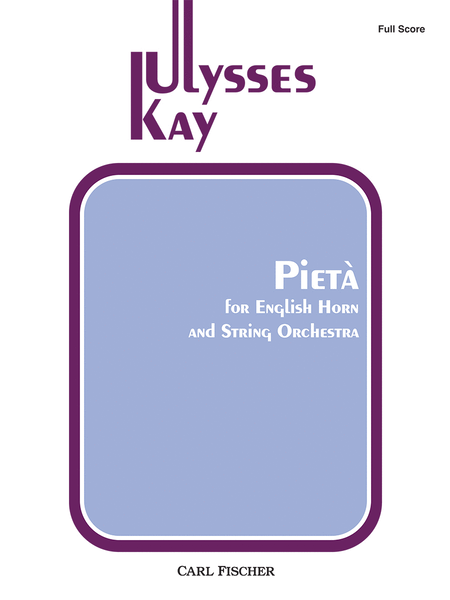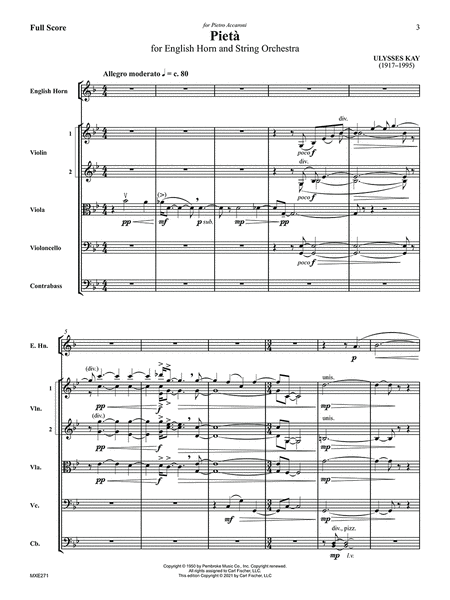Pietà
-
Ships in 1 to 2 weeks
Details
Description
SKU: CF.MXE271
Composed by Ulysses Kay. Full score. 18 pages. Duration 7 minutes. Pembroke Music Co. #MXE271. Published by Pembroke Music Co. (CF.MXE271).ISBN 9781491155257. UPC: 680160913824.
Ulysses Kay was a prolific composer, whose catalog comprises a wide variety of works, including five operas, twenty large works for orchestra, numerous pieces for varied vocal forces and chamber works. His early training was auspicious, working with such distinguished pedagogues as William Grant Still, Howard Hanson, Paul Hindemith and Bernard Rogers. His music received attention and acclaim when the composer was only in his twenties. His numerous honors and awards in his early years include a Guggenheim Fellowship, an American Prix de Rome prize and a Fulbright Scholarship for studies in Europe. Later in his career he was awarded honorary doctorates from Lincoln College, Bucknell University, the University of Arizona and Illinois Wesleyan University. Kay favored neoclassical tendencies in his works, featuring lyricism, contrapuntal textures, clear formal designs and a tonal, yet chromatic harmonic vocabulary, all of which are evident in his PietA from 1950. The workas title, meaning mercy or compassion, was perhaps inspired by Michelangeloas famous sculpture of the Virgin Mary cradling the crucified Christ, which the composer surely would have seen during his stay in Rome. The piece was dedicated to the Italian oboist Pietro Accaroni, who premiered the composeras Suite in B for Oboe and Piano in 1949.
Ulysses Kay was a prolific composer, whose catalog comprises a wide variety of works, including five operas, twenty large works for orchestra, numerous pieces for varied vocal forces and chamber works. His early training was auspicious, working with such distinguished pedagogues as William Grant Still, Howard Hanson, Paul Hindemith and Bernard Rogers. His music received attention and acclaim when the composer was only in his twenties. His numerous honors and awards in his early years include a Guggenheim Fellowship, an American Prix de Rome prize and a Fulbright Scholarship for studies in Europe. Later in his career he was awarded honorary doctorates from Lincoln College, Bucknell University, the University of Arizona and Illinois Wesleyan University. Kay favored neoclassical tendencies in his works, featuring lyricism, contrapuntal textures, clear formal designs and a tonal, yet chromatic harmonic vocabulary, all of which are evident in his Pieta from 1950. The work's title, meaning mercy or compassion, was perhaps inspired by Michelangelo's famous sculpture of the Virgin Mary cradling the crucified Christ, which the composer surely would have seen during his stay in Rome. The piece was dedicated to the Italian oboist Pietro Accaroni, who premiered the composer's Suite in B for Oboe and Piano in 1949.
Ulysses Kay was a prolific composer, whose catalog comprises a wide variety of works, including five operas, twenty large works for orchestra, numerous pieces for varied vocal forces and chamber works. His early training was auspicious, working with such distinguished pedagogues as William Grant Still, Howard Hanson, Paul Hindemith and Bernard Rogers. His music received attention and acclaim when the composer was only in his twenties. His numerous honors and awards in his early years include a Guggenheim Fellowship, an American Prix de Rome prize and a Fulbright Scholarship for studies in Europe. Later in his career he was awarded honorary doctorates from Lincoln College, Bucknell University, the University of Arizona and Illinois Wesleyan University.Kay favored neoclassical tendencies in his works, featuring lyricism, contrapuntal textures, clear formal designs and a tonal, yet chromatic harmonic vocabulary, all of which are evident in his Pietà from 1950. The work’s title, meaning mercy or compassion, was perhaps inspired by Michelangelo’s famous sculpture of the Virgin Mary cradling the crucified Christ, which the composer surely would have seen during his stay in Rome. The piece was dedicated to the Italian oboist Pietro Accaroni, who premiered the composer’s Suite in B for Oboe and Piano in 1949.


 Share
Share